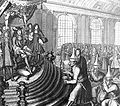
Siamoise is a term for various woven fabric varieties, usually cotton and linen blends, with patterns such as checks and stripes. Siamoise was so named because it imitated clothing worn by 17th century Siamese ambassadors.
History
At first, Siamoise was made with silk in warp and cotton filling yarn. The fabric resembled the clothing of the Siamese (Thai) ambassadors who visited King Louis XIV in 1684 and 1686. That is why the name 'Siamoise' was given to it.
Modifications
Initially, the fabric was a combination of silk and cotton, and the silk warp weakened the material. Replacing the silk with linen produced a stronger fabric that was highly successful.
Further additions
Since then, Siamoise has undergone many additions such as linen and cotton patterns, varied stripes, and checks and blends of different fibers such as silk and wool.
Influences
Further information: Orientalism in early modern FranceThe Siamese Embassy to France in 1686 had brought to the Court samples of multicolor Thai Ikat textiles. These were enthusiastically adopted by the French nobility to become Toiles flammées or Siamoises de Rouen, often with checkered blue-and-white designs. After the French Revolution and its dislike for foreign luxury, the textiles were named "Toiles des Charentes" or cottons of Provence.
Gallery
-
 Siamoise flammée textile, derived from Thai Ikat, French manufacture, 18th century
Siamoise flammée textile, derived from Thai Ikat, French manufacture, 18th century
-
 Siamese embassy to Louis XIV led by Kosa Pan in 1686, by Nicolas Larmessin
Siamese embassy to Louis XIV led by Kosa Pan in 1686, by Nicolas Larmessin
See also
References
- Crowston, Clare Haru (2001-12-07). Fabricating Women: The Seamstresses of Old Regime France, 1675–1791. Duke University Press. p. 375. ISBN 978-0-8223-8306-2.
- ^ Montgomery, Florence M. (1984). Textiles in America 1650-1870 : a dictionary based on original documents, prints and paintings, commercial records, American merchants' papers, shopkeepers' advertisements, and pattern books with original swatches of cloth. Internet Archive. New York; London : Norton. p. 347. ISBN 978-0-393-01703-8.
- ^ Miquelon, Dale (1978). Dugard of Rouen: French Trade to Canada and the West Indies, 1729-1770. McGill-Queen's Press - MQUP. p. 15. ISBN 978-0-7735-0299-4.
- Ciba Review. Ciba Limited. 1939. p. 1124.
- Association, American Historical (1994). Annual Report of the American Historical Association. U.S. Government Printing Office. p. 35.
- McCabe, Ina Baghdiantz (2008) Orientalism in Early Modern France, ISBN 978-1-84520-374-0, Berg Publishing, Oxford, p.222-223